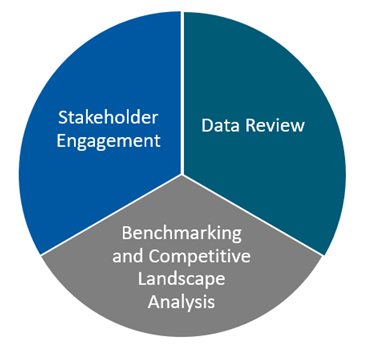
Sustaining Higher Ed is a monthly blog dedicated to helping college administrators and board trustees lead their organizations toward greater financial stability so they can stay on mission during challenging times.
In last month’s post, we described the building blocks of the strategic planning process—stakeholder engagement, data review, and benchmarking and competitive analysis. We also noted that the COVID-19 pandemic has put a new focus on the student, prompting many institutions to rethink the student’s central role in the strategic planning process. This month, we want to take that idea a bit further. What if colleges and universities began to think of students more as customers (which they are)? How might that transform not only the strategic planning process, but the strategic goals and initiatives of the institution?
Focus on your customers, not your competition.
An article published several years ago in the Harvard Business Review offers a key insight for leaders of almost any enterprise: Focus on keeping up with your customers, not your competition. One of the most important changes this focus requires is moving from the question of how to get customers to do what you want to the question of how you can help customers do what they want. Colleges and universities, for example, want students to enroll, to take the courses they offer, and to develop ties to the institution that keep them engaged as alumni after they graduate. Taking the student perspective might lead to a different set of questions, such as:
- Who are our students now, and who do we think they will be in the future? Are we focused, for example, on a residential undergraduate population, non-residential undergraduates, or an adult education population? Are we trying to engage more than one group? How do the perspectives of various student populations differ? How are they the same?
- Why would students want to enroll here? What are they seeking from their experience and how do we help them have that experience?
- How well do our academic course offerings align with what students think are important skills or areas of knowledge for their future? How effective are we in communicating with students about how we help them develop those skills and build that knowledge, and then engaging with them in that process?
- What do our alumni want from an ongoing relationship with our institution? How effectively do the experiences we offer our students begin to build that relationship? How effectively are we meeting alumni expectations?
Institutions may find they do not have easy or ready answers to these questions. If they do not, it may mean that they have been paying more attention to what other colleges and universities are doing than on what their most important customers want. In adopting a customer-centric focus and seeking the answers, they have the opportunity to differentiate themselves from their competition.
Implications for the strategic planning process.
Adopting a customer-centric focus will have implications for the strategic planning process. The fundamentals introduced in last month’s post (shown in the graphic) stay the same, but the questions asked and the information gathered may produce very different conversations and outcomes.

Stakeholder engagement. Faculty engagement will still be critical to the success of a customer-centric strategic planning process, but the process of engagement may differ. If institutional leaders have difficulty answering questions about how they can help their customers (students and alumni) do what they want, faculty will likely have difficulty answering these questions as well. Initial discussions with faculty leaders might explore what is not known about the institution’s customers (students potential, current, and past) and what these customers hope to gain from their experience with the institution. These discussions can, in turn, help frame questions to be pursued through engagement with customer stakeholders.
Discussions with faculty may be difficult at first. Faculty were hired by the institution because of their expertise, and the idea that students might want something other than what they are being given might be antithetical to faculty’s understanding of their role. But faculty are also concerned about the ongoing vitality of their disciplines and departments, and an awareness that this vitality might in fact be strengthened by a more customer-centric approach can change perspectives. If the strategic planning process is transparent and if relevant, reliable data is presented, the odds of effective faculty engagement improve significantly.
Data review. Most institutions have access to lots of data, but a customer-centric focus might raise the question of whether it is the right data. As noted above, engaging faculty in a customer-centric strategic planning process will depend in part on the availability of relevant, reliable data on student and alumni expectations and needs. A customer-centric focus will likely require asking new questions and seeking new data.
The effort to gather data must be multidimensional. It must, in other words, have breadth and depth across the institution, touching upon the student and alumni experience across significant points of contact (e.g., the admissions office, the bursar’s office, the financial aid office, the development office, the office of residential life, etc.) and academic life (e.g., individual schools and departments). This effort helps build transparency, allowing comparisons of performance across different units and a better understanding of what engages the institution’s customers and what does not.
Benchmarking and competitive landscape analysis. Adopting a customer-centric focus does not mean losing sight of the competition; instead, it seeks to improve an institution’s competitive position by strengthening its focus on the customer. If peer institutions are doing a better job at attracting and retaining their customers, it is important to understand why. It is also important to know if your own institution’s metrics are improving in comparison to peer institutions as an indicator that your initiatives are on the right track.
Benchmarking also provides an opportunity to think beyond the immediate competition. One of the points raised by the authors of the Harvard Business Review article cited above is that customer expectations today are liquid. In other words, customers do not think in terms of industry boundaries, and they will compare their customer experience at your institution with the best customer experiences they have had anywhere. Higher education is in many ways unique, but it shares components with other industries (including cultural organizations, the hospitality industry, and professional sports). What organizations—regardless of industry—have a strong reputation for customer experience, and what benchmarks could they provide?
We will be exploring the implications of a customer-centric approach in subsequent blog posts. For now, we encourage everyone to consider how they could realign their strategic focus and initiatives on what their customers expect, and how those expectations could be best fulfilled.







